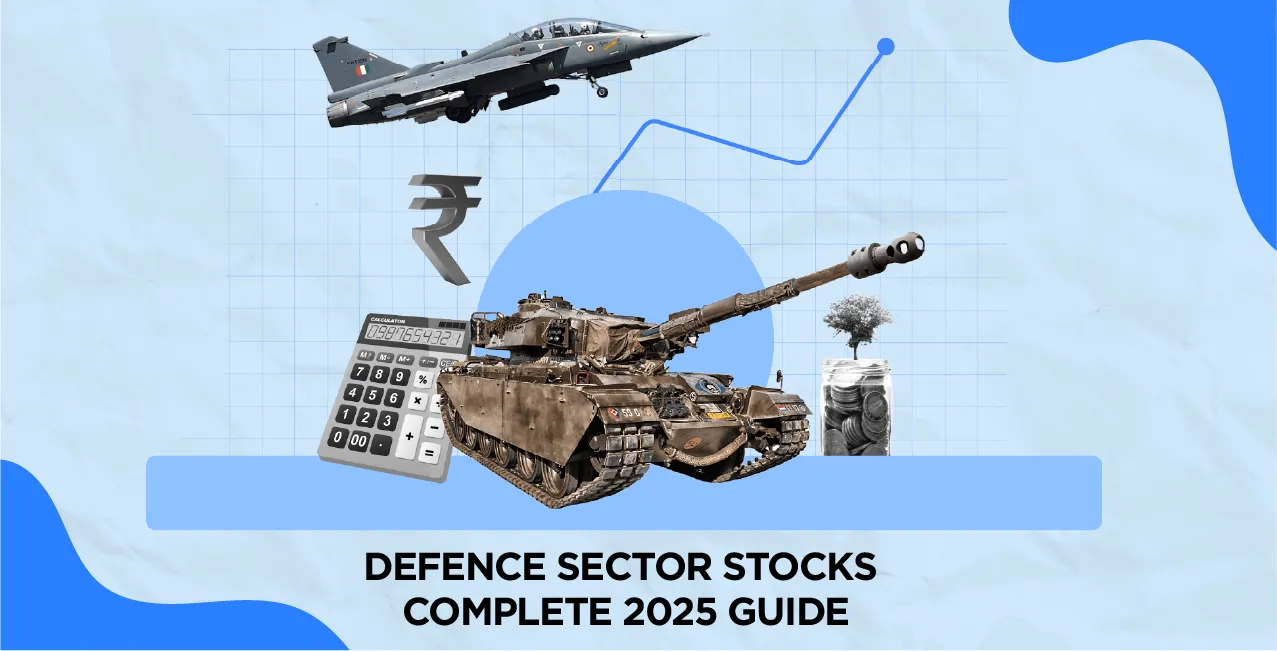
Author
LoansJagat Team
Read Time
17 Min
21 Apr 2025
Defence Sector Stocks – Complete 2025 Guide to Top Picks & Investment Insights
Defence sector stocks are shares of companies involved in producing military equipment, weapons, and related technologies. These companies support national security by supplying products such as aircraft, missiles, warships, tanks, and cybersecurity systems. In India, public and private firms are active in this sector, driven by initiatives like “Make in India” and relaxed foreign direct investment norms.
For instance, imagine a public sector company that specialises in manufacturing advanced missile systems and underwater torpedoes for the armed forces. In a given year, it might have a market capitalisation of ₹500,000,000,000, generate revenue of ₹30,000,000,000, and report a net profit of ₹5,000,000,000.
India’s defence budget for 2024–25 is approximately ₹6,219,408,500,000, with a large amount allocated for capital expenditure, highlighting the government's focus on modernisation. Alongside public enterprises, several private firms might be engaged in building warships, developing surveillance drones, or providing AI-based defence solutions.
What are Defence Sector Stocks & Why invest in Defence Sector Stocks?
Defence stocks represent shares in companies manufacturing military equipment like weapons, ships, and aircraft. These stocks are often seen as relatively stable investments, as defence spending typically remains consistent even during economic downturns. They also offer growth opportunities driven by global demand and technological innovation. However, some investors steer clear of them due to their association with war, conflict, and ethical dilemmas.
Why invest in Defence Stocks?
After researching the stock market for a few weeks, Priya, a 26-year-old software engineer, became interested in sector-based investing. The defence sector stood out to her due to its steady government backing and long-term relevance. While analysing options, she came across Bharat Electronics, a prominent player in the Aerospace & defence space and a large-cap stock on the BSE. What drew her in was not just the company’s reputation, but the stock's current performance. Trading at ₹295.1, it was close to the day’s high of ₹296.45, showing positive intraday momentum. She noted its 52-week range, a low of ₹221 and a high of ₹340.35, which suggested strong long-term growth.
When she looked at recent returns, she saw consistent gains: 0.48% in a day, 5.34% over the past month, and 4.59% in the last three months. On top of that, the technical indicators added to her confidence. With the daily pivot level at ₹294.15, and support and resistance levels giving a clear picture of possible price movements, the data suggested a stable investment opportunity. Given all these factors, Priya felt this was the right time to step into defence stocks, starting with Bharat Electronics.
Why Priya Invested in Defence Stocks :
- Sector Interest: Defence sector supported by consistent government spending and long-term demand.
- Stock Chosen: Bharat Electronics (Largecap, Aerospace & Defence sector).
- Current Price: ₹295.1 — trading close to the daily high of ₹296.45.
- 52-Week Range: ₹221 (low) to ₹340.35 (high), indicating strong long-term performance.
- Recent Returns:
- 1-day return: 0.48%
- 1-month return: 5.34%
- 3-month return: 4.59%
- 1-day return: 0.48%
- Technical Analysis:
- Pivot level: ₹294.15
- Resistance levels: R1 ₹297.1, R2 ₹299.4, R3 ₹302.35
- Support levels: S1 ₹291.85, S2 ₹288.9, S3 ₹286.6
- Pivot level: ₹294.15
Reasons to Invest in Defence Sector Stocks
Arjun, a 29-year-old financial analyst, had been exploring sectors that offer long-term stability, strong government support, and technological growth. While scanning the markets, he grew interested in defence sector stocks, especially after tracking the performance of Hindustan Aeronautics Ltd. (HAL) and Bharat Electronics Ltd. (BEL). Here's what convinced him to invest:
1. Strong Government Backing and Sector Stability
Defence spending by the government remains consistent even during economic slowdowns. With increasing focus on “Make in India” and indigenous production of defence equipment, companies like HAL and BEL are positioned to benefit from government contracts and policy support.
Factor | HAL | BEL |
Sector | Aerospace & Defence | Aerospace & Defence |
Classification | Largecap (BSE) | Largecap (BSE) |
Govt. Dependency | High (strategic contracts) | High (radars, electronics) |
Policy Support | Yes (Make in India, exports) | Yes (Digital India, R&D grants) |
2. Consistent Long-Term Returns
When Arjun reviewed the long-term performance data, he noticed both stocks had delivered remarkable multi-year returns. HAL showed a 5-year return of 1407.72%, while BEL had a 5-year return of 1139.05%, highlighting the compounding potential in the sector.
Read More – Drone Stocks in India
Time Frame | HAL Return (%) | BEL Return (%) |
1 Week | 4.65 | 5.32 |
1 Month | 22.65 | 5.34 |
3 Months | 2.47 | 4.59 |
6 Months | -6.6 | 3.74 |
1 Year | 14.7 | 27.69 |
3 Years | 385.45 | 247.38 |
5 Years | 1407.72 | 1139.05 |
3. Attractive Entry Points via Technicals
Arjun used technical analysis to plan his entry. For instance, HAL’s current price of ₹4218.6 is near its pivot level (₹4221.53), with clear support and resistance levels guiding its trade. BEL, on the other hand, was trading near its resistance but showing upward momentum.
Stock | Current Price | Pivot Level | Support (S1) | Resistance (R1) |
HAL | ₹4218.6 | ₹4221.53 | ₹4191.47 | ₹4248.07 |
BEL | ₹295.1 | ₹294.15 | ₹291.85 | ₹297.1 |
4. Positive Moving Averages Indicating Momentum
HAL’s short-term and long-term moving averages showed strong momentum. For instance, the 5-day EMA of ₹4157.09 and the 10-day SMA of ₹4156.19 indicated that the stock was riding a steady upward trend. BEL also maintained a stable moving average pattern.
Duration | HAL SMA | HAL EMA |
5-day | ₹4128 | ₹4157.09 |
10-day | ₹4156.19 | ₹4123.18 |
20-day | ₹3922 | ₹4014.41 |
50-day | ₹3684.47 | ₹3881.62 |
100-day | ₹3961.6 | ₹3950.09 |
200-day | ₹4334.13 | ₹3986.18 |
5. Diversified Exposure within Defence
Instead of putting all his capital into one company, Arjun diversified within the defence sector. HAL focuses on aircraft manufacturing and aerospace, while BEL specialises in defence electronics and radar systems, giving it broad exposure to different defence verticals.
Company | Focus Area | Strategic Advantage |
HAL | Aircraft, helicopters, aerospace | High-margin govt contracts, exports rising |
BEL | Radars, avionics, communication | R&D investment, stable cash flows |
Arjun’s decision to invest in HAL and BEL wasn’t just based on hype it was a combination of solid fundamentals, long-term performance, supportive policies, and smart technical analysis. For investors looking to build a future-ready portfolio with relatively lower volatility and strong government backing, defence sector stocks make a compelling case.
Key Factors Affecting Defence Stocks
Let's consider the example of Raj, a 35-year-old investor, who decided to put ₹5,00,000 into Bharat Electronics Ltd. (BEL) back in 2022. He made this decision after evaluating the key factors that could impact the performance of defence stocks:
Factor | Impact on Defence Stocks |
Government Policies and Budget Allocation | Higher defence budgets and supportive policies like Make in India and FDI reforms boost domestic manufacturing and company growth. |
Geopolitical Environment | Border tensions and international defence partnerships increase defence spending and order flows to companies. |
Company-Specific Fundamentals | A strong order book, R&D investment, and timely project execution ensure revenue visibility and long-term performance. |
Industry Trends | Military modernisation and tech innovations (AI, drones, cybersecurity) drive demand for advanced defence solutions. |
Competitors and Partnerships | PSUs and private firms compete; foreign collaborations and joint ventures can enhance technology access and market position. |
Regulatory Environment | Clear procurement and export policies improve deal execution, reduce delays, and create export opportunities. |
Financial Performance | Companies with strong revenue, profit margins, and low debt are more stable and better positioned to manage long project cycles. |
Global Trends | Global defence spending and supply chain shifts create export potential and demand for self-reliant manufacturing. |
Best Defence Stocks in India
Note: This data has been taken from the official website of Google Finance.
Stock Name | Market Cap( | P/E ratio | Dividend Yield (%) | 1 year return (%) |
Bharat Electronics Ltd | 2.14T INR | 42.77 | 0.79 | 24.55 |
Hindustan Aeronautics Ltd | 2.81T INR | 32.37 | 0.90 | 16.06 |
Bharat Dynamics Ltd | 503.66B INR | 89.07 | 0.32 | 55.69 |
Mazagon Dock Shipbuilders Ltd | 1.04T | 37.97 | 0.56 | 144.49 |
Cochin Shipyard Ltd | 386.15B INR | 48.37 | 0.66 | 39.65 |
Data Patterns (India) Ltd | 99.47B INR | 55.72 | 0.37 | -37.50 |
Sika Interplant Sysytems Ltd | 13.61B INR | 56.40 | 0.31 | 75.07 |
CFF Fluid Control Ltd | 8.88B INR | 42.28 | 0.22 | 6.94 |
Paras Defence and Space Technologies Ltd | 41.04B INR | 74.62 | - | 49.08 |
Unimech Aerospace and Manufacturing Ltd | 42.92B INR | 70.25 | - | -29.30 |
Factors to Consider Before Investing in Defence Sector Stocks in India
Ananya, a 30-year-old software engineer from Bengaluru, was keen on investing in the defence sector, recognising its growth potential driven by government initiatives and technological advancements. After thorough research, she identified Data Patterns (India) Ltd. as a promising candidate.
Factors Ananya Considered Before Investing in Data Patterns (India) Ltd.
1. Robust Financial Performance
Data Patterns reported a net profit of ₹30.28 crore for the July-September 2024 quarter. While this represented a slight decline from the previous year, the company maintained healthy margins and operational efficiency.
2. Strong Order Book
As of September 30, 2024, the company had an order book valued at ₹1,053.22 crore, indicating a solid pipeline of projects and future revenue streams.
3. Government Contracts and Policy Support
Data Patterns collaborates closely with defence PSUs like Hindustan Aeronautics Ltd and Bharat Electronics Ltd, as well as organisations such as DRDO and ISRO, positioning it favourably within government-backed defence initiatives.
4. Investment in Research and Development
The company allocates a significant portion of its revenue to R&D, fostering innovation in electronic systems and subsystems for defence and aerospace applications.
5. Export Potential
With a growing international presence, Data Patterns expanded its export portfolio, contributing to a diversified revenue stream and reducing dependency on domestic contracts.
6. Diversified Product Portfolio
The company's offerings span various segments, including radars, electronic warfare systems, and avionics, providing exposure to multiple facets of the defence sector.
The Outcome
Ananya invested ₹1,00,000 in Data Patterns (India) Ltd. Over the next year, the company's stock appreciated by 15%, elevating her investment to ₹1,15,000. This growth mirrored the company's strong financials, strategic government partnerships, and commitment to innovation.
Ananya’s investment glimpse:
Factor | Data Patterns (India) Ltd. | Significance |
Financial Performance | Net profit of ₹30.28 crore in Q2 FY25 | Indicates strong profitability and operational efficiency |
Order Book | ₹1,053.22 crore as of September 30, 2024 | Reflects a robust pipeline of future projects |
Government Collaborations | Partnerships with HAL, BEL, DRDO, and ISRO | Ensures steady revenue through government support |
R&D Investment | Significant allocation to R&D | Drives innovation and technological advancement |
Export Growth | Expanding international presence | Diversifies revenue streams and reduces domestic dependency |
Product Diversification | Range of defence and aerospace electronic systems | Provides exposure to various high-growth segments |
Challenges and Risks in Defence Stocks
Risk Factor | Description | Illustrative Example |
Dependence on Government Orders | Defence companies often rely heavily on government contracts. Delays or cancellations can significantly impact revenues. | In the movie Jawan, a military mission fails due to malfunctioning weapons supplied by a private defence company. This fictional scenario underscores the real-world risks when companies fail to meet contractual obligations, leading to mission failures and loss of lives. |
Political Risks | Changes in political leadership or defence policies can alter funding priorities and procurement decisions, affecting company prospects. | The 1987 Bofors scandal in India revealed how political interference and corruption in defence deals can lead to significant controversies, impacting the reputation and operations of involved companies. |
Market Liquidity | Some defence stocks have low trading volumes, making it difficult for investors to buy or sell large quantities without affecting the stock price. | Investors in niche defence companies may face challenges in executing large trades swiftly, potentially leading to unfavourable pricing or inability to exit positions promptly during market downturns. |
Operational and Quality Risks | Defence products must meet stringent quality standards. Failures can lead to contract losses, legal liabilities, and reputational damage. | The malfunctioning weapons scenario in Jawan reflects the critical importance of quality assurance in defence manufacturing. Real-world lapses can have severe consequences, including loss of life and national security breaches. |
Corruption and Ethical Concerns | The defence sector has been susceptible to corruption scandals, which can tarnish company reputations and lead to legal challenges. | Incidents like the AgustaWestland chopper scam highlight how corruption in defence procurement can have far-reaching implications for companies, including contract cancellations and legal penalties. |
Future of Defence Stocks in India
In 2025, India's defence sector continues to present promising opportunities for investors, driven by robust government support, increasing exports, and a focus on technological advancements. Let's explore this through the example of Neha, a 30-year-old professional, and her investment journey with Bharat Electronics Ltd. (BEL).
In 2022, Neha invested ₹1,00,000 in BEL when the share price was approximately ₹100. Over the next two years, BEL secured significant government contracts, expanded its exports, and ventured into new technologies. By 2024, the share price rose to ₹150, marking a 50% gain. Her investment grew to ₹1,50,000.
Now, in 2025, Neha is contemplating further investments in the defence sector. To make an informed decision, she examines the current landscape.
Current Trends in India's Defence Sector
Point | Explanation |
Government Support | Initiatives like 'Make in India' and 'Atmanirbhar Bharat' are bolstering domestic defence manufacturing, providing a conducive environment for companies like BEL to thrive. |
Higher Defence Spending | The government is allocating more funds to modernise the armed forces, leading to increased demand for advanced equipment and systems. |
Growing Exports | India's defence exports surged to ₹23,622 crore in FY 2024-25, with a target of ₹50,000 crore by 2029, indicating a strong international demand for Indian defence products. |
Strong Order Books | Major companies like HAL, BEL, and MDL have substantial pending orders, ensuring revenue visibility and business stability in the coming years. |
Private Sector Entry | Private firms such as Solar Industries and Astra Microwave are entering the defence space, fostering innovation and competition. |
Focus on Technology | The sector is increasingly emphasising technologies like AI and machine learning, with companies investing in R&D to stay ahead. |
Key Defence Companies to Watch
Company | Specialisation | Significance |
HAL | Aircraft and helicopters | Crucial for Air Force modernisation efforts. |
BEL | Radars and communication systems | Consistent profits and a diverse product portfolio. |
MDL | Naval warship construction | Integral to strengthening naval capabilities. |
BDL | Missiles and rockets | Enhancing India's missile technology and export potential. |
Cochin Shipyard | Shipbuilding and repairs | Supporting naval expansion and maintenance. |
Solar Industries | Explosives and defence materials | Growing presence in defence exports and private sector innovation. |
Addressing Current Market Concerns
While some defence stocks have experienced slight declines in 2025, it's essential to consider the underlying fundamentals. Companies maintain strong financial health, robust order books, and are aligned with government initiatives. Such market corrections can present opportunities for investors to enter or increase holdings at more attractive valuations.
Also Read - Top 10 Defence Stocks in India
Who Should Invest in Defence Stocks?
1. Long-Term Investors
Defence stocks tend to be stable and resilient, particularly due to long-term government contracts and national security demands. This makes them attractive for investors looking for consistent returns over time.
Why Defence Stocks Suit Them | Example |
Defence companies have long-term government contracts, ensuring consistent revenue over time. This stability is perfect for those looking for steady returns. | A company with a ₹10,000 crore contract to supply aircraft over 10 years guarantees ₹1,000 crore annual revenue, providing steady returns. |
2. Risk-Averse Investors
Defence stocks are relatively low-risk compared to more volatile sectors. The consistent demand for military products and technologies protects them from large market swings.
Why Defence Stocks Suit Them | Example |
The defence sector is less affected by market volatility due to its government backing and constant demand for defence products. | Even during an economic downturn, defence spending remains stable. For example, in 2024, India allocated ₹6,219,408,500,000 to its defence budget. |
3. Tech Enthusiasts and Innovators
If you’re interested in emerging technologies, from AI to drones and cybersecurity, defence companies are often at the forefront of these innovations.
Why Defence Stocks Suit Them | Example |
Defence companies lead in technological innovation, with products like AI-powered drones and advanced cybersecurity systems. | A company developing AI-based missile defence systems may see exponential growth, with market potential reaching ₹5,000 crore annually. |
How to Invest in Defence Stocks?
1. Open a Demat and Trading Account
- Choose a Broker: Select a reputable brokerage firm such as Angel One, Groww, or Upstox.
- Account Opening: Visit the broker's website or app to open a Demat and trading account. This process typically involves:
- Providing personal details (name, PAN, Aadhaar, bank account information).
- Completing KYC (Know Your Customer) verification, which may include Aadhaar-based e-KYC or video verification.
- E-signing the application using an OTP sent to your Aadhaar-linked mobile number.
- Providing personal details (name, PAN, Aadhaar, bank account information).
- Link Bank Account: Associate your bank account with the trading account for seamless transactions.
2. Research Defence Stocks
Before investing, it's crucial to research and identify potential defence stocks. Some prominent defence companies in India include:
- Hindustan Aeronautics Ltd (HAL): Specialises in aircraft and helicopter manufacturing.
- Bharat Electronics Ltd (BEL): Focuses on defence electronics and communication systems.
- Mazagon Dock Shipbuilders Ltd (MDL): Engaged in naval shipbuilding.
- Bharat Dynamics Ltd (BDL): Known for missile systems and guided weaponry.
- Cochin Shipyard Ltd: Involved in shipbuilding and repairs.
- Solar Industries India Ltd: Manufactures explosives and defence materials.
For instance, according to a report by Groww, as of 2025, Bharat Electronics has an analyst rating of 85.71%, indicating strong investor confidence. Groww
3. Place Your Order
- Log In: Access your trading account through the broker's app or website.
Search Stocks: Use the search function to find the defence stock you're interested in. - Buy Order: Enter the number of shares you wish to purchase and the price at which you're willing to buy.Angel One
- Confirm: Review the details and confirm the order.
4. Monitor Your Investment
- Track Performance: Regularly check the performance of your investments through your trading account.
- Stay Informed: Keep abreast of news related to the defence sector, government policies, and global geopolitical developments that may impact your investments.
Final Thoughts: Should You Invest in Defence Stocks?
The Indian defence sector has undoubtedly enjoyed a golden run between 2021 and 2024, driven by ambitious government policies, geopolitical tailwinds, and a wave of investor optimism. Stocks like HAL and BEL soared, attracting both institutional and retail investors looking for long-term growth stories.
But 2025 has brought a new reality: the bull run is slowing, and many investors are left wondering: Is the defence rally over? Or is it just taking a breather?
The Shift in Market Sentiment
In bull markets, every dip feels like a buying opportunity. But in changing market cycles, sentiment becomes more cautious. With defence stocks showing signs of fatigue,double-bottom sell patterns, triangle breakdowns, and bearish anchor columns, it’s clear the momentum has cooled. That doesn’t mean the opportunity is gone, but it does mean investors need to be more selective and strategic.
What Should You Look for in 2025?
Instead of chasing past performance, focus on objective, measurable factors that can help you evaluate if a defence stock still holds promise:
Key Factor | What to Monitor in 2025 | Why It Matters |
Trend Reversal Levels | HAL: ₹4,300 / BEL: ₹300 | Breach above these may indicate renewed bullish momentum |
Technical Patterns | Watch for continuation or reversal formations (example: triangle breakouts, double tops) | Helps in identifying the next price direction |
Valuation Comfort | Check P/E and P/B ratios vs the sector average | Avoid overpaying in a cyclical sector |
New Order Inflows | Government defence contracts, export deals | Directly impacts revenue and stock sentiment |
R&D and Innovation | Investment in drones, AI, radar tech, etc. | Fuels long-term differentiation and export potential |
The Case For Defence Stocks
- Structural Growth: India’s defence budget continues to rise year-on-year.
- Government Support: Initiatives like Atmanirbhar Bharat and Make in India are ongoing.
- Export Ambitions: India is pushing to become a global arms supplier.
- Private Sector Entry: Startups and tech firms are adding innovation and scalability.
The Case Against Defence Stocks
Momentum Loss: Key stocks have shown bearish trends in 2025.
Valuation Concerns: Many stocks may have already priced in expected growth.
Global Headwinds: Any geopolitical easing or policy shift could reduce defence demand.
Cyclical Risk: Defence stocks, like all themes, go through periods of hype and consolidation.
Other Informative Pages | |||
About the Author

LoansJagat Team
‘Simplify Finance for Everyone.’ This is the common goal of our team, as we try to explain any topic with relatable examples. From personal to business finance, managing EMIs to becoming debt-free, we do extensive research on each and every parameter, so you don’t have to. Scroll up and have a look at what 15+ years of experience in the BFSI sector looks like.

Quick Apply Loan
Subscribe Now
Related Blog Post


